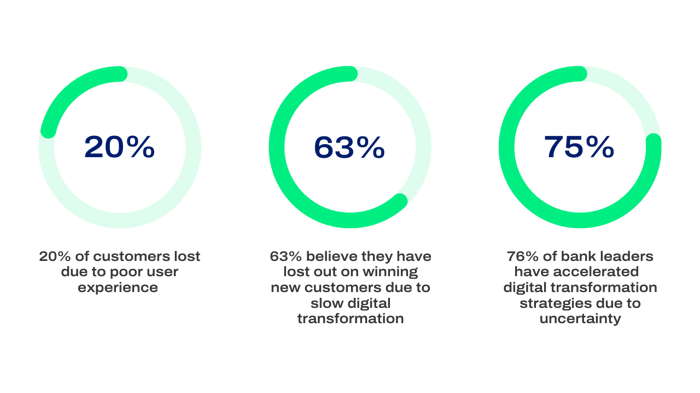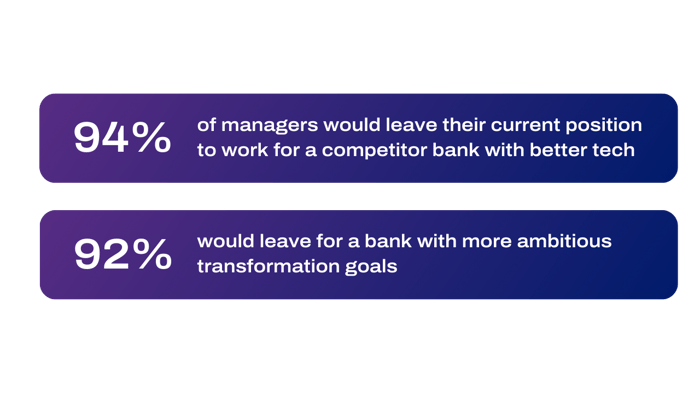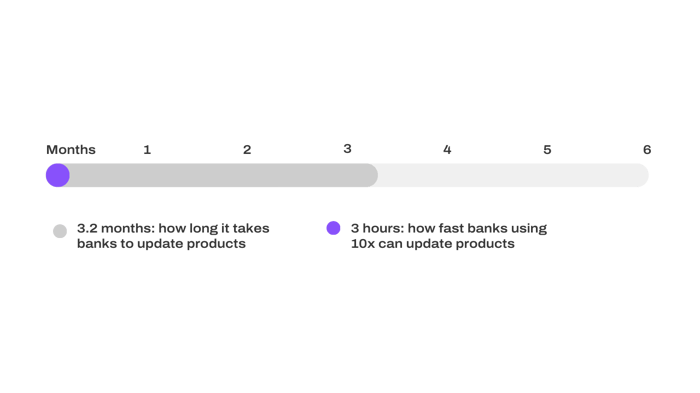The future of banking is digital transformation, but why is achieving it such a struggle? Our recent research sheds some light.
Banks have lost a fifth (20%) of customers because of poor user experience. Digital transformation offers a way to fix this, but almost two-thirds (63%) of banks say they've lost potential customers because of slow transformation.

The figures come from research conducted by us here at 10x. We spoke to 300 bankers across EMEA and APAC (150 leaders and 150 product managers, business analysts, and project managers) to understand the state of transformation. The data suggests that only a relentless customer-centric approach will enable banks to reach their goals with digital transformation. And that requires a shift in priorities.
"Banking is about customers, but the reality is that most of the banking industry has lost the ability to prioritize what matters," says Antony Jenkins, CEO and founder of 10x Banking. "Banks need to think about solving problems to make the customers' lives easier."
Why should banks be more customer-centric?
Our research found that banks are challenged by talent retention and the pace of change. But they are also optimistic about their chances of delivering an experience that customers expect.
Their optimism may be misplaced, however. Today's customers have lofty expectations – and they are not just set by neobanks but also by forward-thinking businesses across all sectors.
"If you're sitting in an established bank, you're not necessarily sure where to look for inspiration," says Leda Glyptis, Chief Client Officer at 10x Banking. "You know that the customers are asking for certain things. But the reality is that the customer's own imagination is constrained by the art of the possible."
Enjoying the blog? Download the full report today.
Neobanks are built to deal with the demands of modern consumers. They deploy updates 4.6 times more often than incumbents. Digital transformation programs intend to close the gap, but two-thirds of those surveyed say their transformation programs are less advanced as they want them to be.
The link between talent and transformation
Talented staff play an important role in customer-centric banking. The knowledge they develop helps establish what customers want and ensures the company can deliver it.

It's not encouraging, then, that 94 percent of managers surveyed say they would leave their current role to go to a bank with better technology. In comparison, 92 percent would leave for a bank with more ambitious transformation goals. "This suggests to me that the people on the ground know they're making very marginal improvement against what is a significant opportunity," says Antony.
In contrast, 94 percent of leaders say they are confident they are staying ahead of the competition. Are they complacent in thinking they can win the fight for customers? It appears they are currently overlooking the competition for talent.
How fast is fast enough for banking customers today?
The speed of technological change affects all businesses. Customers are surrounded by cues that set expectations. For example, smartphone apps often get updated weekly to fix bugs or add features.
But weekly releases are out of reach for most banks – we found it takes banks 3.8 months to bring a new product to market and 3.5 months to update an existing one.
"What becomes interesting for the bank is to start shifting the mindset and governance to overlay this new world. For instance, if you could launch a new product in minutes, could you A/B test your ideas in-market rather than spend two months doing focus groups?" asks Leda. "It could be cheaper, better, and more exciting for your consumers to get the product live and see which they prefer. And if one doesn't perform well, then migrating people to the alternative is easy with the right infrastructure."

With a modern banking platform like 10x SuperCore®, banks can make changes in minutes and push them live on the same day. This kind of timeframe makes it easier to delight customers because it makes the bank feel genuinely responsive. That's a powerful feeling; customers may eventually go elsewhere to get it.
A tech stack that enables transformation
For banks to unlock their potential, they must address the underlying technology. "Banks are museums of technology. Their core systems operate on centuries-old hardware," says Antony. "The perception that digital transformation takes months is an illusion based on their existing limited parameters. By moving a bank's core technology to a modern, cloud-native system, the parameters cease to exist."
Shifting to a cloud-native core banking platform would lay the foundations for meaningful digital transformation at speeds fit for the modern world. It puts the customer at the center of the bank, enabling faster product releases and updates, providing access to data in real-time across the entire customer relationship, and improving operational and cost efficiency. All of which enable a better customer experience.
When asked what holds them back from cloud-native core banking, respondents pointed to a lack of control over customer data, a desire to keep things in-house, and regulatory concerns. Despite these concerns, 80% say that outsourced cloud-based banking systems would accelerate transformation.
Chase UK is an example of what can be done. Using 10x's core banking platform, Chase has been able to onboard more than 1.6 million customers in the 20 months since its launch in September 2021. Chase is processing millions of transactions per day, with customers highly engaged with the digital bank's product offer.
This feat would seem impossible to most leaders and managers in their current frame of mind. Yet it's possible, as Chase has proven, through a transformative approach – from the bank's core outwards. This is the future of banking.
Read the full report
Learn about our core banking transformation capabilities or get in touch with the team to learn more.



